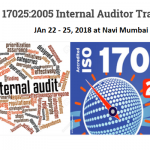OHSAS 18001 DOCUMENTATION,IMPLEMENTATION & CERTIFICATION :- WHITE PAPER
OHSAS 18001:2007 Standard -Bringing organizations to new heights of occupational safety and health (OH&S) performance.
ABSTRACT
All organizations, regardless of their size or complexity are faced with the challenge of implementing an occupational safety and health (OH&S) management system that would prevent injuries and ill health to persons that are working under the control of the organization (contractors, employees). The Occupation Health and Safety Assessment Series (OHSAS) 18001 standard has been successfully adopted by many organizations to manage their (OH&S) hazards and risks.
This article examines the drivers for the revision of the standard, the changes and how they would affect organizations in terms of raising their safety and health performance.
1. INTRODUCTION
OHSAS 18001 is a standard that specifies how an occupational safety and health management system should be designed. The standard provides a framework for organizations, regardless of their complexity or size, to holistically manage their occupational safety and health risks though a simple PLAN-DO-CHECK-ACT system of management. This management model is found in other management system standards such as ISO 9001 and ISO 14001. Therefore organizations have found it convenient to integrate OHSAS 18001 into their existing ISO 9001 and/or ISO 14001 systems.
OHSAS 18001 was first released in 1999. The standard was primarily fashioned after the very successful ISO 14001 standard and the BS8800 standard which were released in 1996. Like other national and international standards, OHSAS 18001 undergoes a revision process. In 2007, the revision of OHSAS 18001:1999 was completed and the new version was released in July that year.
2. DRIVERS FOR REVISION
Firstly, organization as well as regulators wanted a standard that drives performance. That means, by implementing the standard, organization should be able to reduce accidents and incidents in the workplace.
Areas which need improvement are as follows:
• The boundaries of organizations today are no longer rigidly defined as before. Organizations have to address issues arising from travel patterns of employees and transportation of their goods and services.
• Organizations should extend the boundaries of their occupational health programme to address psychosocial needs of their workers, such as mental health. This is in light of changes to the nature of work patterns, for example working from home, shift work and work-related stress may lead to accidents or occupationally related illness at the workplace.
• Organizations are not effectively identifying and assessing their occupational safety and health risks. As risk assessment is the heart of the safety management system, lack of proper risk identification and implementation of control measures would translate to an inadequate OH&S management system.
• There is a need for greater involvement of workers, and contractors in the development and implementation of the organization’s occupational safety and health management systems.
• Organizations need to be in a constant proactive surveillance mode to identify opportunities that might help to prevent accidents, unsafe practices or conditions.
3. CHANGES AND HOW THEY WOULD DRIVE ORGANIZATIONS TO ACHIEVE HIGHER STANDARDS OF OH&S PERFORMANCE
Changes in the standard can be broadly classified into the following areas:
• Clarity – polishing of the terms to minimize ambiguity in the standard,
• Consistency – alignment with other mgt system standards.
• Comprehensiveness – addressing all possible drivers of accidents.
• Control & Continual Improvement – increasing effectiveness of controls
1.1 Clarity
The major stumbling block in an organization’s journey towards implementing the OH&S management system was the ambiguity in terminology resulting in employees, auditors and consultants have different views on how to implement the requirements of the standard. In OHSAS 18001:2007, the authors made changes to the definitions of a number of key terms resulting in significant headway in the following areas:
• Organizations are now expected to manage their risks to acceptable levels. The term “tolerable risk” was replaced with the term “acceptable riskâ€. OHSAS 18001 authors felt that organizations should work towards ensuring risks are “acceptable†from a regulatory, management or best practices point of view rather than just “living†or “tolerating†it.
• The definition of “incident†has been expanded to include terms such as accident, “near-hitâ€, “close call†and “emergency situationâ€. The root causes of “near-hits/misses†are the same as accidents and hence should be accorded the same importance.
• To address the psychological implications of hazards and incidents have on employees, a new term as been added to the standard, termed as “ill healthâ€. Ill health has been defined as identifiable, adverse physical or mental condition arising from and/or made worse by a work activity and/or work related situation.
• As this is an occupational safety and health standard, the definition of hazard and risks explicitly make reference to injuries and ill-health and not physical damage to property.
• The scope of who is an “interested party†is described in greater detail. It is now given as person or group, inside or outside the workplace concerned with or affected by the OH&S performance of an organization.
3.2 Consistency
Much effort went into ensuring the revised OHSAS 18001 is aligned with other management system standards and guidelines. This will facilitate integration of different management systems by organisations.
In ISO 14001, organizations are required to include a commitment to the prevention of pollution in their policy statement. The OH&S policy now requires the organizations to explicitly mention that they are committed to prevention of injury and ill health.
To be aligned with ISO 14001, a new clause has been included on “Evaluation of compliance” (Clause 4.5.2). Not only does this requirement bring it into alignment with ISO 14001, it would contribute to OSHAS 18001 being positioned as a standard driving OH&S performance.
3.3 Control & Continual Improvement
The standard has been redrafted to assist organizations better control their OH&S risks and to achieve higher standards of OH&S performance through cycles of continual improvement.
3.3.1 Commitment to improving OH&S performance
The OH&S policy is now required to explicitly mention that the organization is committed to continually improve its OH&S performance and not just its management system. This requirement makes OHSAS 18001 different from ISO 14001.
3.3.2 Resources, roles, responsibility, accountability and authority
For organizations to achieve higher levels of OH&S performance, there must be commitment in terms of physical and organization resources. The clause on Structure and responsibility is now termed as resources, roles, responsibility, accountability and authority. The additional terms introduced are “accountability†and “authorityâ€. This is to stress that accountabilities and authority are needed to facilitate the effective functioning of the OH&S management system.
To facilitate the immediate correction of unsafe conditions or acts, the identity of the top management appointee should be made available to all persons working under control of the organization. This would allow such persons to turn to their management representative if they feel their immediate supervisors are not addressing their OH&S concerns in the workplace.
OH&S Performance cannot be achieved by a single individual, therefore the standard requires that all persons in the workplace take responsibility for aspects of OH&S over which they have control, including adherence to organization’s applicable OH&S requirements.
3.3.3 Operational control
Neglecting management of change and contractor management could compromise severely the OH&S Performance of the organization; therefore the revised standard requires such considerations to be addressed.
3.3.4 Emergency preparedness and response
To mitigate the impact of emergencies on the OH&S performance of the organization, the standard has provided a structured approach on how organizations should address emergencies, which is as follows:
ï€®ï€ Organizations need to identify emergency situations/scenarios ï€®ï€ Respond to such emergency situations ï€®ï€ Account for needs of relevant interested parties in developing the
emergency situations ï€®ï€ Periodic testing of the emergency response plans should also include the relevant interested parties
The new revised clause would enable organizations to develop more rigid and effective plans to deal with emergencies
3.3.5 Incident investigation
What actions should the organization take after an incident to prevent an identical or similar incident from happening? Accidents, incidents, non-conformances and corrective and preventive actions used to be lumped together in one clause. Now it is separated into two separate sub-clauses, one on incident investigation and another on nonconformity, corrective action and preventive action. For the clause on incident investigation, new requirements have been introduced for the investigation procedures of incidents:
ï€®ï€ They should determine root causes
ï€®ï€ Identify the need for corrective actions ï€®ï€ Identify opportunities for preventive actions ï€®ï€ Identify opportunities for continual improvement ï€®ï€ Communication of the results of investigation
This provides organizations a directed approach of the purpose of doing incident investigation It is not a fault finding exercise but an opportunity to determine root causes so as prevent recurrences.
3.4 Comprehensiveness
Greater emphasis has been given to occupational ill health and the role of human factors in occupational safety and health management. This makes the standard more comprehensive. For example, new requirements have been added to clauses such as
Hazard identification, risk assessment and determination of controls, Operational control and Competence, training and awareness.
Hazard identification, risk assessment and determination of controls (HIRA DC)
The requirements on HIRADC will result in a more thorough identification of hazards and this would subsequently result in better management of OH&S risks. The standard now requires the following considerations:
• Human factors such as behavior, capabilities
• Hazards originating outside of the workplace
• Hazards created in the vicinity of the work-related activities
• Change management in terms of modifications to OHS management system or modifications to the organization, its activities or materials
• Legal obligations on the conduct of HIRADC
With better identification of hazards and risks, organizations are now required to follow a structured way in reducing worker exposure to these risks, which is based on the following hierarchy:
a) elimination b) substitution c) engineering controls d) signage/warnings and/or administrative controls e) personal protective equipment.
As we move down the hierarchy of controls, we are given less assurance of the ability of the controls in minimizing exposure to the hazards.
The information obtained from the HIRADC is required to be fed back to the entire OH&S management system. This would ensure that information regarding OH&S risks and determined controls is translated to the establishment, implementation and maintenance of the OH&S management
3.5 Competence, training and awareness
A systematic approach to competency building, training and raising awareness is advocated by the standard. This includes carrying out a training needs analysis to identify competency gaps and the training required and a system of reviewing the effectiveness of the training after training has been completed.
4 CONCLUSION
The intent of the standard can be reflected diagrammatically as below:
Part A: The OHSAS 18001 standard is to ensure the occupational safety and health of contractors, visitors and employees. Users of the standard in particular should pay attention to the areas where there is interaction of the three groups – workers, contractors and visitors to ensure OHSAS 18001 system elements such as communication, participation and consultation are addressed.
Part B: The OHSAS 18001 standard will address the hazards in the workplace arising from the interaction of equipment, materials, environment and procedures. This process of hazard identification will change whenever there are changes to equipment, materials, environment (including individuals affected by the work activities) and procedures.
Part C: From the hazards identified in the workplace, a risk assessment is done taking into consideration the probability and consequence of the risk being realized in terms of injury and ill health to the workers, contractors and visitors. The risks determination would include legal and other requirements to which the organization subscribes.
The 2007 version of OHSAS 18001 is very promising in brining organizations to new heights of OH&S performance as it provides
• Clarity – in definition and clauses of what the scope/intent of the OH&S standard – occupational health and safety of employees, visitors and contractors and not property damage.
• Consistency – alignment with other management system and therefore allowing integration with them.
• Facilitating organizations to Control and Continually improve its OH&S performance, which is explicitly, mentioned in OH&S Policy clause, operational control, incident investigation, corrective and preventive action clauses.
• Comprehensiveness –holistically addressing all occupational safety and health issues affecting the individual such as ill health, human factors, etc. The standard also demands a comprehensive approach in identifying all hazards and risks in the workplace – hazards arising from issues such as management of change, contractors.








